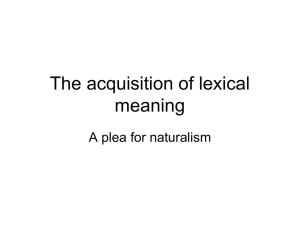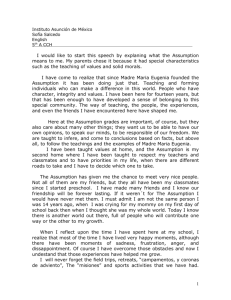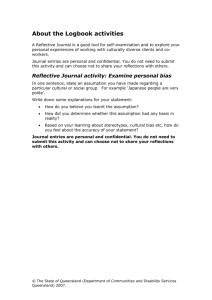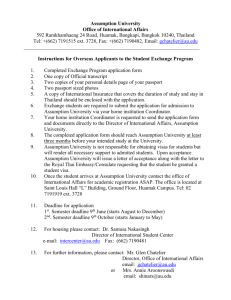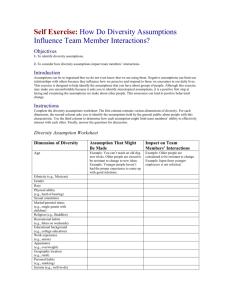Lexical meanings: The Problem of Induction
advertisement
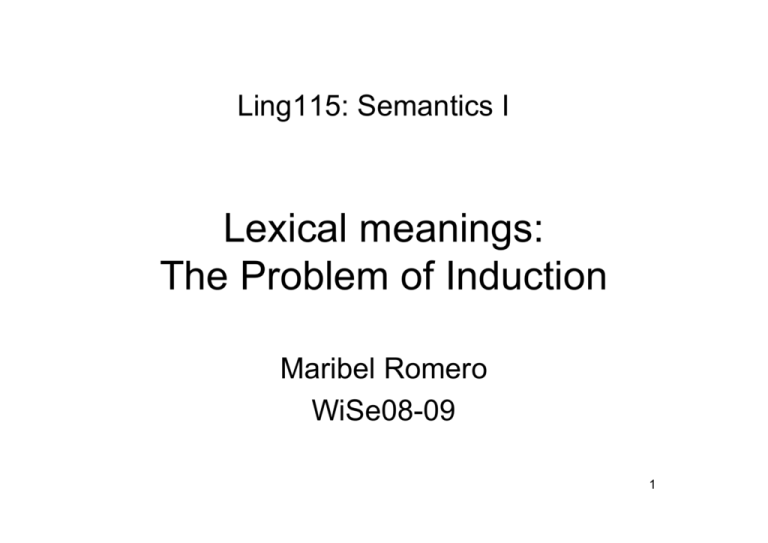
Ling115: Semantics I Lexical meanings: The Problem of Induction Maribel Romero WiSe08-09 1 Table of Contents 1. The problem of induction as applied to language. 2. Markman (1990) on the acquisition of the meaning of nouns. 3. Gleitman & Gleitman (1992) on the acquisition of nouns versus verbs. 4. Conclusions. 2 Table of Contents 1. The problem of induction as applied to language. 2. Markman (1990) on the acquisition of the meaning of nouns. 3. Gleitman & Gleitman (1992) on the acquisition of nouns versus verbs. 4. Conclusions. 3 The Problem of Induction • For a given universe set U, the number of sets of individuals and relations that we can construct is very large. How do we end up choosing the right set for the right word in practice? • Children acquire words and their meaning at a very fast rate (from 18 months to 6 yrs, average of 9 words per day). Do children follow some preferences or “asumptions” to find out the right meanings in such short period of time? • Are these preferences or “assumptions” different for nouns and for verbs? 4 Quine’s (1960) Gavagai • The native / father says gavagai upon seeing a rabbit hopping around. • The explorer / child has to make a hypothesis as to what the word means: – “rabbit” - “furry” - “small and cute” – “rabbit tail” – “hopping actitivity done by furry creatures”, etc. • Quine notes that, for any set of data, there will be many hypotheses consistent with it. How do we induce the correct hypothesis? • How does a child induce the correct meaning so 5 quickly and based on so few stimuli? Goodman’s (1983:74ff) grue and bleen 1/3 • Predicate green It applies to all things examined before and after time t just in case they are green. • Predicate grue It applies to all things examined before t just in case they are green and to all things examined after t just in case they are blue. • Why does the predicate green feel more natural (as having a more sensible meaning) than the predicate grue? 6 Goodman’s (1983:74ff) grue and bleen 2/3 • Case 1: Suppose all the emeralds that we have examined before a certain time t are green. This equally supports the hypotheses that all emeralds are green and that all emeralds are grue. Why do we prefer the first hypothesis? 7 Goodman’s (1983:74ff) grue and bleen 3/3 • Case 2: One could argue that grue’s meaning is a complex meaning built from the simpler -hence more natural-- meanings of green and blue. But, logically, we could also take grue (and bleen) as having the simpler --hence more natural-- meanings and define green and blue as the complex ones. Question: Show how. Bleen applies to all things examined before t just in case they are blue and to all things examined after t just in case they are green. Why do green and blue feel more natural?8 Table of Contents 1. The problem of induction as applied to language. 2. Markman (1990) on the acquisition of the meaning of nouns. • • • • Assumptions children make Experiment A Experiment B Experiment C 3. Gleitman & Gleitman (1992) on the acquisition of nouns versus verbs. 4. Conclusions. 9 Markman (1990) • Main claim: Humans are constrained to consider only some hypotheses or at least to give them priority over others. • In particular, when making hypotheses about word meanings, children make the following assumptions. 10 Assumptions • Taxonomic Assumption: Words refer to objects of the same kind (e.g. dog1, dog2,…) rather than to objects that are thematically related (e.g. cow + milk, baby + bottle). • Whole Object Assumption: A word refers to an entire object, rather than to a part of it, to its substance, its color, etc. • Mutual Exclusivity Assumption: Word meanings are mutually exclusive. That is, each object will have one and only one label. (For a weaker version of this, see Clark’s notion of Contrast). All these are initial assumptions or preferences. If the child encounters counterevidence, obviously they will be violated.11 The Taxonomic Assumption 1/6 • Experiment with 4-yrs and 5-yrs olds. • Procedure: – New objects are presented to the child. The objects are either taxonomically or thematically related to each other, and children are trained on their relation. – No Word Condition: the new object receives no label. – Novel Word Condition: the new object is labeled with a novel word. 12 The Taxonomic Assumption 2/6 • Example of taxonomic training: “This swims in the water.” “This swims in the water.” 13 The Taxonomic Assumption 3/5 • Example of thematic training: “This catches this.” 14 The Taxonomic Assumption 4/6 • No Word Condition: “I’m going to show you something. Then I want you to think carefully, and find another one.” “See this?” “Can you find another one?” 15 The Taxonomic Assumption 5/6 • Novel Word Condition: “I’m going to show you a dax. Then I want you to think carefully, and find another dax.” “See this dax? Can you say dax?” “Can you find another dax?” 16 The Taxonomic Assumption 6/6 • Results: Taxonomic choice: No Word 37% Novel Word 63% • Results of similar experiment with 18- to 24-montholds: Taxonomic choice: No Word 32% Novel Word 77% • Conclusion: although thematic relations are interesting to the child and even preferred in the absence of labels, the child is biased towards the taxonomic relation as far as language is concerned. 17 Assumptions • Taxonomic Assumption: Words refer to objects of the same kind (e.g. dog1, dog2,…) rather than to objects that are thematically related (e.g. cow + milk, baby + bottle). • Whole Object Assumption: A word refers to an entire object, rather than to a part of it, to its substance, its color, etc. • Mutual Exclusivity Assumption: Word meanings are mutually exclusive. That is, each object will have one and only one label. (For a weaker version of this, see Clark’s notion of Contrast). All these are initial assumptions or preferences. If the child encounters counterevidence, obviously they will be violated. 18 Whole Object and Mutual Exclusivity Assumptions • When the child already knows one label / word for a certain whole object and a new label is given, a conflict arises between the Whole Object Assumption and the Mutual Exclusivity Assumption. • Several potential ways to resolve the conflict: – Drop Mutual Exclusivity Assumption – Drop Whole Object Assumption and assign new label to: a part of the object Experiments A & B its substance Experiments C a hypernym etc. 19 Experiment A: part of object 1/2 • 3- and 4-year-olds • The child is presented with an object with a noticeable part. • Two Conditions: – Familiar condition: the child knew the object and the label for the whole object. – Unfamiliar condition: the child knew neither the object nor its label. In neither condition does the child know the label of the part. • A new label is then presented. 20 Experiment A: part of object 2/2 • Results: Familiar New label assigned to the noticeable part 57% Unfamiliar 20% • That is: children normally adhere to the Whole Object Assumption. But, in case of conflict between Whole Object and Mutual Exclusivity (as in the Familiar Condition), they tend to violate the former assumption and assign the new label to a part of the object. 21 Experiment B: part of object 1/2 • The child is presented with an object with a noticeable part. • Two Conditions: – Familiarization condition: the child did not know the object, but the object is presented to him accompanied with a label. – Unfamiliar condition: the child knew neither the object nor its label, and this remains so. In neither condition does the child know the label of the part. • A new label is then presented. 22 Experiment B: part of object 2/2 • Results: New label assigned to the noticeable part Familiarization 85% Unfamiliar 32% • Hence, the conclusion from experiment B is confirmed. Children adhere to the Whole Object Assumption. But, in case of conflict with Mutual Exclusivity, they violate the former and assign the new label to a part. 23 Experiment C: substance 1/2 • 3- and 4-year-olds • The child is presented with an object made out of a new substance or material. • Two Conditions: – Familiar condition: Half the children heard See this? It is pewter applied to a familiar object, e.g. a metal cup. – Unfamiliar condition: Half the children heard See this? It is pewter applied to an unfamiliar object, e.g. a pair of metal tongs. • A similar object made of a different substance is then presented, e.g. a ceramic cup or wooden tongs. The child is asked whether it is pewter. 24 Experiment C: substance 2/2 • Results: New label assigned to the substance Familiar Unfamiliar 11/12 5/12 • That is: the conclusions from experiments A and B are replicated for substance. Children normally adhere to the Whole Object Assumption. But, in case of conflict with Mutual Exclusivity, they tend to violate the former and assign the new label to the substance rather than to the whole object. 25 Conclusions from Markman • Despite the logical problem of induction, children are very efficient at inferring the correct meaning for new words because they adhere to some innate (violable) preferences: – Taxonomic Assumption – Whole Object Assumption – Mutual Exclusivity Assumption 26 Table of Contents 1. The problem of induction as applied to language. 2. Markman (1990) on the acquisition of the meaning of nouns. 3. Gleitman & Gleitman (1992) on the acquisition of nouns versus verbs. • • • Experiment 1 Experiment 2 Experiment 3 4. Conclusions. 27 Gleitman and Gleitman (1992) Main problems on acquisition of verb meanings: • General problem of induction: (1) Mother says “Do you want this ice cream cone?” while she’s smiling, speaking, holding the cone, etc. • More to be learnt than in the case of nouns: - number of participants in event: jump vs hit - type of action: touch vs. hit, want vs. think - perspective of the event: doublets give/get, chase/flee, feed/eat, etc. 28 Gleitman and Gleitman (1992) • G&G’s claim: syntax helps semantics Rather than word-event pairing, children attempt sentence-event pairing and use the syntactic structure of the sentence to help them discover the meaning of the verb. This is so even for very young children (16-/18month olds) that only produce 1-word utterances. • Assumptions about the mapping from syntax to semantics: - the number of arguments in the sentence correlates with the number of participants in the actual event - the subject of the sentence tends to be the agent of the event 29 Experiment 1 • 16- and 18-month olds • Two video-screens: Video-screen 1: Big Bird tickles Cookie Monster Video-screen 2: Cookie Monster tickles Big Bird • Two descriptions, each heard by half the children Big Bird is tickling Cookie Monster. Cookie Monster is tickling Big Bird. • Results: children looked longest at the screen that matched the syntax. • Conclusion: Children parse (some) syntax at 16-/18- months. Children assume the subject is the agent. 30 Experiment 2 1/2 • 22- to 24-month olds • Video scene: Video scene Duck forces bunny to squat, & each wheels his arm on a circle. • Different descriptions of the video scene are given to different children using the made-up verb biff. Transitive sentence: The duck is biffing the bunny. Intransitive sentence: The duck and the bunny are biffing. • The child hears Find biffing now! and has to choose between two new scenes: Scene 1 Duck forces bunny to squat Scene 2 Duck and bunny wheel their arms 31 Experiment 2 2/2 • Results: 15 out of 16 children chose the scene that matched the syntax of the sentence where biff was introduced, that is: Transitive sentence → Scene 1 with agent and patient Intransive sentence → Scene 2 with only agents • Conclusion: Children map the number of arguments in the sentence to the number of participants in the actual event to help themselves pin down the meaning of a new verb. 32 Experiment 3: Doublets 1/2 • 3- and 4-yr olds • Video scene Video scene A rabbit runs across the screen form left to right. As it is disappearing, a skunk runs in the same direction. • A puppet, speaking puppet lg, gives different descriptions of this scene to different children: Look! Biffing! The skunk is biffing the rabbit. The rabbit is biffing the skunk. • The child is then asked to explain what the puppet 33 meant. Experiment 3: Doublets 2/2 • Results Puppet said: Look! Biffing! The skunk is biffing the rabbit The rabbit is biffing the skunk Child explained it as “He is chasing him”: 80% 90% 30% • Conclusions: In the case of doublet meanings like “chase”/ “flee”, there is a preference for the Agent-oriented meaning (i.e., agent as subject, as in “chase”). This preference is considerably lessened when the syntactic evidence is against it. 34 Conclusions from Gleitman and Gleitman • Syntax helps children figure out different aspects of the meaning/event described by a new verb: - number of participants in event - type of action - perspective of the event Experiment 2 Experiments 1& 3 • The use of syntax to underpin the meaning of new verbs starts at least as early as 16-/18-months. 35 Table of Contents 1. The problem of induction as applied to language. 2. Markman (1990) on the acquisition of the meaning of nouns. 3. Gleitman & Gleitman (1992) on the acquisition of nouns versus verbs. 4. Conclusions. 36 Conclusions • The philosophical problem of induction applies to the acquisition of lexical meanings. How do children acquire the correct meanings? • For nouns, children adhere to some innate (violable) preferences: – Taxonomic Assumption – Whole Object Assumption – Mutual Exclusivity Assumption • For verbs, syntax helps children figure out: - number of participants in event - type of action - perspective of the event 37

